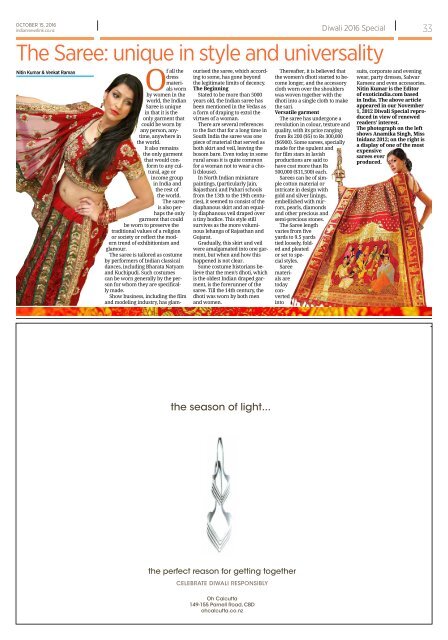Create successful ePaper yourself
Turn your PDF publications into a flip-book with our unique Google optimized e-Paper software.
OCTOBER <strong>15</strong>, <strong>2016</strong><br />
Diwali <strong>2016</strong> Special<br />
33<br />
The Saree: unique in style and universality<br />
Nitin Kumar & Venkat Raman<br />
Of all the<br />
dress<br />
materials<br />
worn<br />
by women in the<br />
world, the <strong>Indian</strong><br />
Saree is unique<br />
in that it is the<br />
only garment that<br />
could be worn by<br />
any person, anytime,<br />
anywhere in<br />
the world.<br />
It also remains<br />
the only garment<br />
that would conform<br />
to any cultural,<br />
age or<br />
income group<br />
in India and<br />
the rest of<br />
the world.<br />
The saree<br />
is also perhaps<br />
the only<br />
garment that could<br />
be worn to preserve the<br />
traditional values of a religion<br />
or society or reflect the modern<br />
trend of exhibitionism and<br />
glamour.<br />
The saree is tailored as costume<br />
by performers of <strong>Indian</strong> classical<br />
dances, including Bharata Natyam<br />
and Kuchipudi. Such costumes<br />
can be worn generally by the person<br />
for whom they are specifically<br />
made.<br />
Show business, including the film<br />
and modeling industry, has glam-<br />
ourised the saree, which according<br />
to some, has gone beyond<br />
the legitimate limits of decency.<br />
The Beginning<br />
Stated to be more than 5000<br />
years old, the <strong>Indian</strong> saree has<br />
been mentioned in the Vedas as<br />
a form of draping to extol the<br />
virtues of a woman.<br />
There are several references<br />
to the fact that for a long time in<br />
South India the saree was one<br />
piece of material that served as<br />
both skirt and veil, leaving the<br />
bosom bare. Even today in some<br />
rural areas it is quite common<br />
for a woman not to wear a choli<br />
(blouse).<br />
In North <strong>Indian</strong> miniature<br />
paintings, (particularly Jain,<br />
Rajasthani and Pahari schools<br />
from the 13th to the 19th centuries),<br />
it seemed to consist of the<br />
diaphanous skirt and an equally<br />
diaphanous veil draped over<br />
a tiny bodice. This style still<br />
survives as the more voluminous<br />
lehanga of Rajasthan and<br />
Gujarat.<br />
Gradually, this skirt and veil<br />
were amalgamated into one garment,<br />
but when and how this<br />
happened is not clear.<br />
Some costume historians believe<br />
that the men’s dhoti, which<br />
is the oldest <strong>Indian</strong> draped garment,<br />
is the forerunner of the<br />
saree. Till the 14th century, the<br />
dhoti was worn by both men<br />
and women.<br />
Thereafter, it is believed that<br />
the women’s dhoti started to become<br />
longer, and the accessory<br />
cloth worn over the shoulders<br />
was woven together with the<br />
dhoti into a single cloth to make<br />
the sari.<br />
Versatile garment<br />
The saree has undergone a<br />
revolution in colour, texture and<br />
quality, with its price ranging<br />
from Rs 200 ($5) to Rs 300,000<br />
($6900). Some sarees, specially<br />
made for the opulent and<br />
for film stars in lavish<br />
productions are said to<br />
have cost more than Rs<br />
500,000 ($11,500) each.<br />
Sarees can be of simple<br />
cotton material or<br />
intricate in design with<br />
gold and silver linings,<br />
embellished with mirrors,<br />
pearls, diamonds<br />
and other precious and<br />
semi-precious stones.<br />
The Saree length<br />
varies from five<br />
yards to 9.5 yards<br />
tied loosely, folded<br />
and pleated<br />
or set to special<br />
styles.<br />
Saree<br />
materials<br />
are<br />
today<br />
converted<br />
into<br />
suits, corporate and evening<br />
wear, party dresses, Salwar<br />
Kameez and even accessories.<br />
Nitin Kumar is the Editor<br />
of exoticindia.com based<br />
in India. The above article<br />
appeared in our November<br />
1, 2012 Diwali Special reproduced<br />
in view of renewed<br />
readers’ interest.<br />
The photograph on the left<br />
shows Anamika Singh, Miss<br />
Inidanz 2012; on the right is<br />
a display of one of the most<br />
expensive<br />
sarees ever<br />
produced.<br />
the season of light...<br />
the perfect reason for getting together<br />
CELEBRATE DIWALI RESPONSIBLY<br />
Oh Calcutta<br />
149-<strong>15</strong>5 Parnell Road, CBD<br />
ohcalcutta.co.nz


















